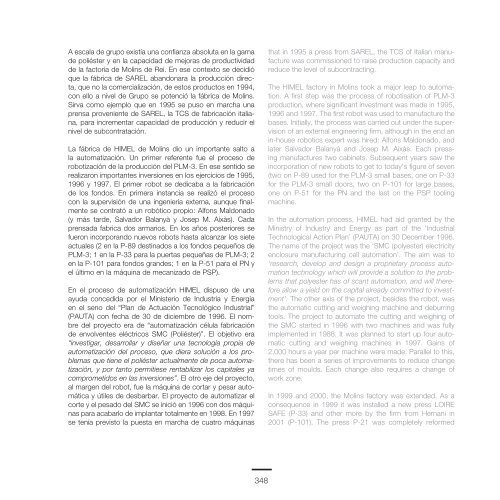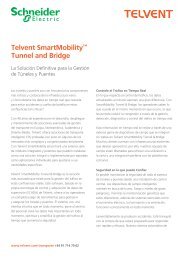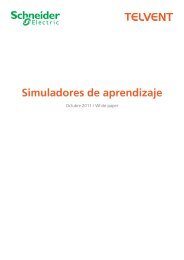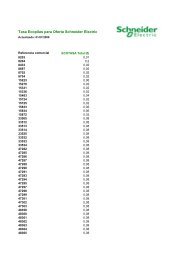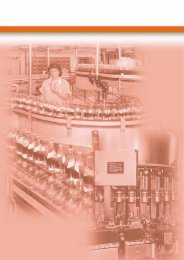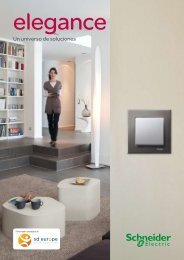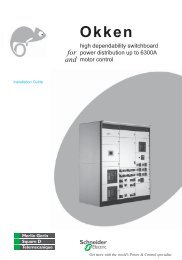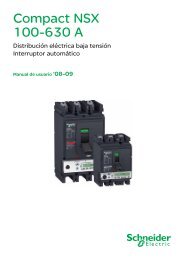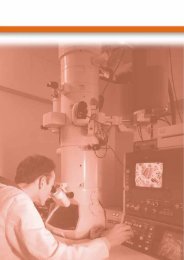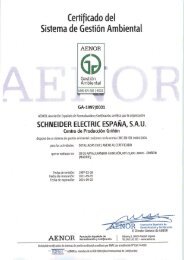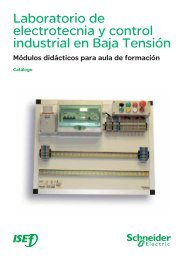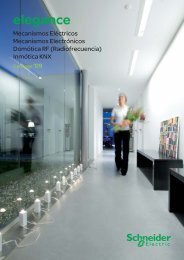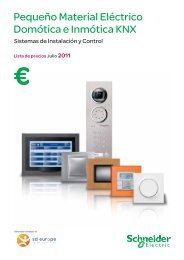Untitled - Schneider Electric
Untitled - Schneider Electric
Untitled - Schneider Electric
Create successful ePaper yourself
Turn your PDF publications into a flip-book with our unique Google optimized e-Paper software.
A escala de grupo existía una confianza absoluta en la gamade poliéster y en la capacidad de mejoras de productividadde la factoría de Molins de Rei. En ese contexto se decidióque la fábrica de SAREL abandonara la producción directa,que no la comercialización, de estos productos en 1994,con ello a nivel de Grupo se potenció la fábrica de Molins.Sirva como ejemplo que en 1995 se puso en marcha unaprensa proveniente de SAREL, la TCS de fabricación italiana,para incrementar capacidad de producción y reducir elnivel de subcontratación.La fábrica de HIMEL de Molins dio un importante salto ala automatización. Un primer referente fue el proceso derobotización de la producción del PLM-3. En ese sentido serealizaron importantes inversiones en los ejercicios de 1995,1996 y 1997. El primer robot se dedicaba a la fabricaciónde los fondos. En primera instancia se realizó el procesocon la supervisión de una ingeniería externa, aunque finalmentese contrató a un robótico propio: Alfons Maldonado(y más tarde, Salvador Balanyà y Josep M. Aixàs). Cadaprensada fabrica dos armarios. En los años posteriores sefueron incorporando nuevos robots hasta alcanzar los sieteactuales (2 en la P-89 destinados a los fondos pequeños dePLM-3; 1 en la P-33 para la puertas pequeñas de PLM-3; 2en la P-101 para fondos grandes; 1 en la P-51 para el PN yel último en la máquina de mecanizado de PSP).En el proceso de automatización HIMEL dispuso de unaayuda concedida por el Ministerio de Industria y Energíaen el seno del “Plan de Actuación Tecnológico Industrial”(PAUTA) con fecha de 30 de diciembre de 1996. El nombredel proyecto era de “automatización célula fabricaciónde envolventes eléctricos SMC (Poliéster)”. El objetivo era“investigar, desarrollar y diseñar una tecnología propia deautomatización del proceso, que diera solución a los problemasque tiene el poliéster actualmente de poca automatización,y por tanto permitiese rentabilizar los capitales yacomprometidos en las inversiones”. El otro eje del proyecto,al margen del robot, fue la máquina de cortar y pesar automáticay útiles de desbarbar. El proyecto de automatizar elcorte y el pesado del SMC se inició en 1996 con dos máquinaspara acabarlo de implantar totalmente en 1998. En 1997se tenía previsto la puesta en marcha de cuatro máquinasthat in 1995 a press from SAREL, the TCS of Italian manufacturewas commissioned to raise production capacity andreduce the level of subcontracting.The HIMEL factory in Molins took a major leap to automation.A first step was the process of robotisation of PLM-3production, where significant investment was made in 1995,1996 and 1997. The first robot was used to manufacture thebases. Initially, the process was carried out under the supervisionof an external engineering firm, although in the end anin-house robotics expert was hired: Alfons Maldonado, andlater Salvador Balanyà and Josep M. Aixàs. Each pressingmanufactures two cabinets. Subsequent years saw theincorporation of new robots to get to today’s figure of seven(two on P-89 used for the PLM-3 small bases, one on P-33for the PLM-3 small doors, two on P-101 for large bases,one on P-51 for the PN and the last on the PSP toolingmachine.In the automation process, HIMEL had aid granted by theMinistry of Industry and Energy as part of the ‘IndustrialTechnological Action Plan’ (PAUTA) on 30 December 1996.The name of the project was the ‘SMC (polyester) electricityenclosure manufacturing cell automation’. The aim was to‘research, develop and design a proprietary process automationtechnology which will provide a solution to the problemsthat polyester has of scant automation, and will thereforeallow a yield on the capital already committed to investment’.The other axis of the project, besides the robot, wasthe automatic cutting and weighing machine and deburringtools. The project to automate the cutting and weighing ofthe SMC started in 1996 with two machines and was fullyimplemented in 1988. It was planned to start up four automaticcutting and weighing machines in 1997. Gains of2,000 hours a year per machine were made. Parallel to this,there has been a series of improvements to reduce changetimes of moulds. Each change also requires a change ofwork zone.In 1999 and 2000, the Molins factory was extended. As aconsequence in 1999 it was installed a new press LOIRESAFE (P-33) and other more by the firm from Hernani in2001 (P-101). The press P-21 was completely reformed348


